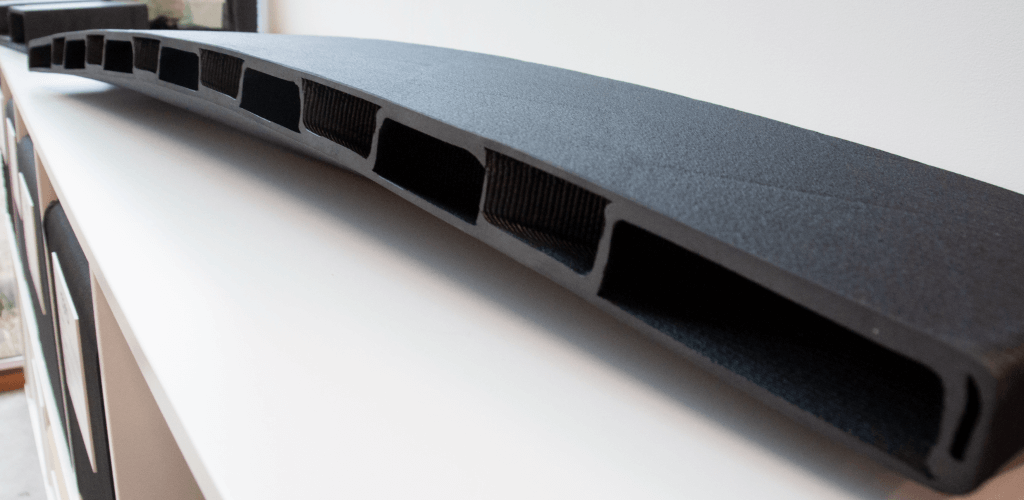Engineering company Royal HaskoningDHV is collaborating with polymer company DSM and composites 3D Printing company CEAD to build a pedestrian bridge. CEAD is a Delft-based company that is commercializing a large scale continuous fiber 3D printing process. Their CFAM Prime process can make glass or carbon fiber reinforced parts that are four by 2 by 1.5 meters in size. Carbon Fiber Reinforced Polymer materials have a wide range of applications. The design freedom of 3D printing combined with these materials could lead to an entirely new way of constructing bridges and other construction parts.
We’ve heard a lot about concrete printing over the past years. At the same time, large scale polymer printers have been used for molds for formwork which lets one make large scale parts for tunnels and other structures. CEAD and BAAM systems have experimented with structural parts directly but this is to be the first pedestrian bridge 3D printed out of polymers.
By combining polymers with continuous fiber a lightweight stiff structure can emerge with very high strength. Some issues may remain in some cases such a structure may be too brittle for applications as bridges. In the past, many 3D printed buildings have tended to fail when they come into contact with the elements especially things like freezing temperatures. These things will have to be ironed out but this is a very exciting development indeed.

Maurice Kardas, Business Development Manager at Royal HaskoningDHV, said,
“This collaboration will bring about a paradigm shift in the way we think of the form and functionality in bridges. Fiber Reinforced Plastic bridges have been known for their long life spans and lower overall costs in comparison with steel bridges. Now we will be using a new 3D printing technology which lets us at scale make fiber-reinforced plastic parts.
“Through adding sensors to the bridge we can make a ‘digital twin’ of the bridge itself. These sensors can predict and optimize maintenance, ensure safety and lengthen the life span of bridges.”
Patric Duis, Segment Leader Additive Manufacturing bij DSM stated,
“Using Arnite has significant advantages in bridge building. Instead of traditional materials such as steel and concrete, we can make more environmentally friendly bridges with more flexible design and through using recyclable materials. Designs that would before have been challenging or even impossible..can now be made through 3d printing.”
Concrete is a huge pollutant and it would be a great development to see bridges made of recyclable materials or bridges that can be recycled. Arnite is a stiff PBT or PET material that could, especially in its PET form be ideal for this. Composites themselves are very difficult to recycle, however.
The team will have to show that these complex materials can also actually be turned into something useful end of life. Many recycling processes for these materials have yet to be developed. Smart manufacturers are already turning to natural fibers to create composites that enable easy end of life recycling.
What’s also interesting is that CEAD has a printing method Fused Granulate Fabrication that works based on granulate. Many of the large scale 3D printing technologies are granulate based since this reduces the cost of parts. Will granulate become a trend in medium-format 3D printing as well, or will these larger printers stick to filament? Will someone develop an integrated recycling solution capable of producing polymer formwork or structures such as bridges out of recycled materials? That, of course, will really turn this into an ideal solution for long-lasting environmentally friendly construction.
Subscribe to Our Email Newsletter
Stay up-to-date on all the latest news from the 3D printing industry and receive information and offers from third party vendors.
Print Services
Upload your 3D Models and get them printed quickly and efficiently.
You May Also Like
Consolidation in AM: How 2025 Is Shaping the Industry’s New Normal
The first half of 2025 has been marked by a clear shift in the additive manufacturing (AM) industry. Companies are no longer just focused on developing new tech by themselves....
Etsy Design Rule Change Reduces Selection of 3D Printed Goods
Online marketplace Etsy has implemented a rule change requiring all 3D printed goods on the site to be original designs. The update to the site’s Creativity Standards states, ¨Items produced using...
U.S. Congress Calls Out 3D Printing in Proposal for Commercial Reserve Manufacturing Network
Last week, the U.S. House of Representatives’ Appropriations Committee moved the FY 2026 defense bill forward to the House floor. Included in the legislation is a $131 million proposal for...
Transforming From Tourist to Native: Duro CEO Michael Corr Explains Why the Company Rebuilt its PLM Software on AI
In these early innings of the AI boom, many market analysts have expressed concern that AI spend has gotten too far ahead of the technology’s proven ability to deliver significant...

































